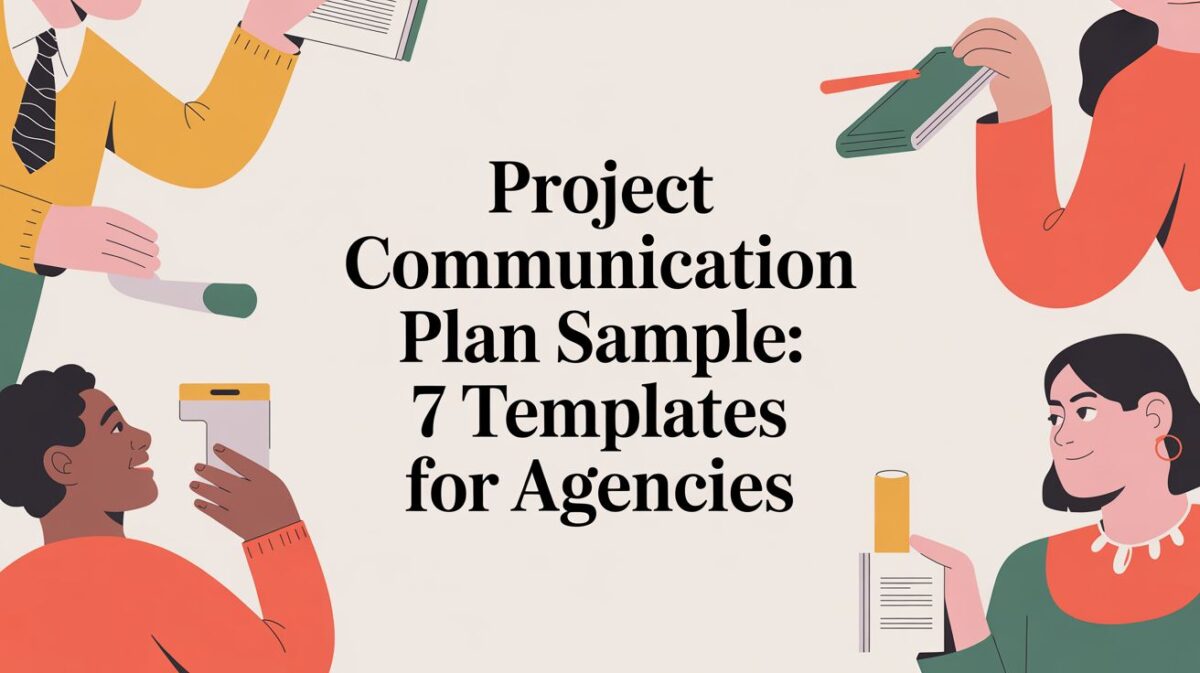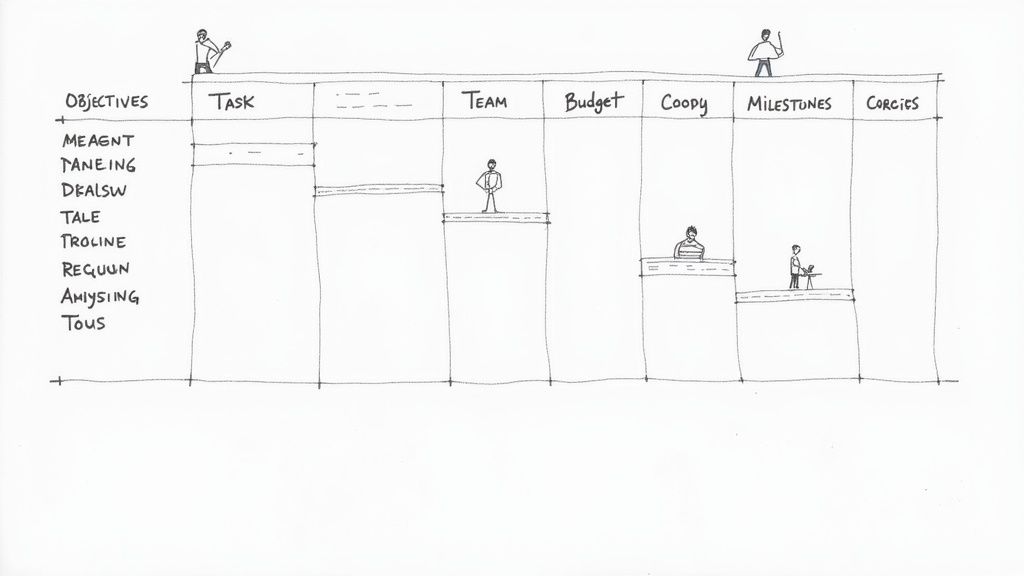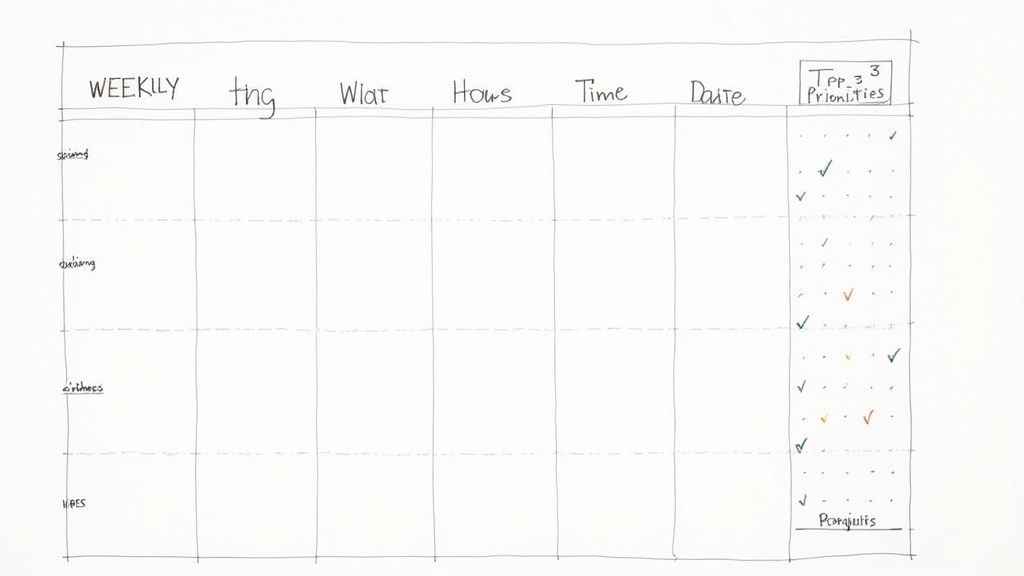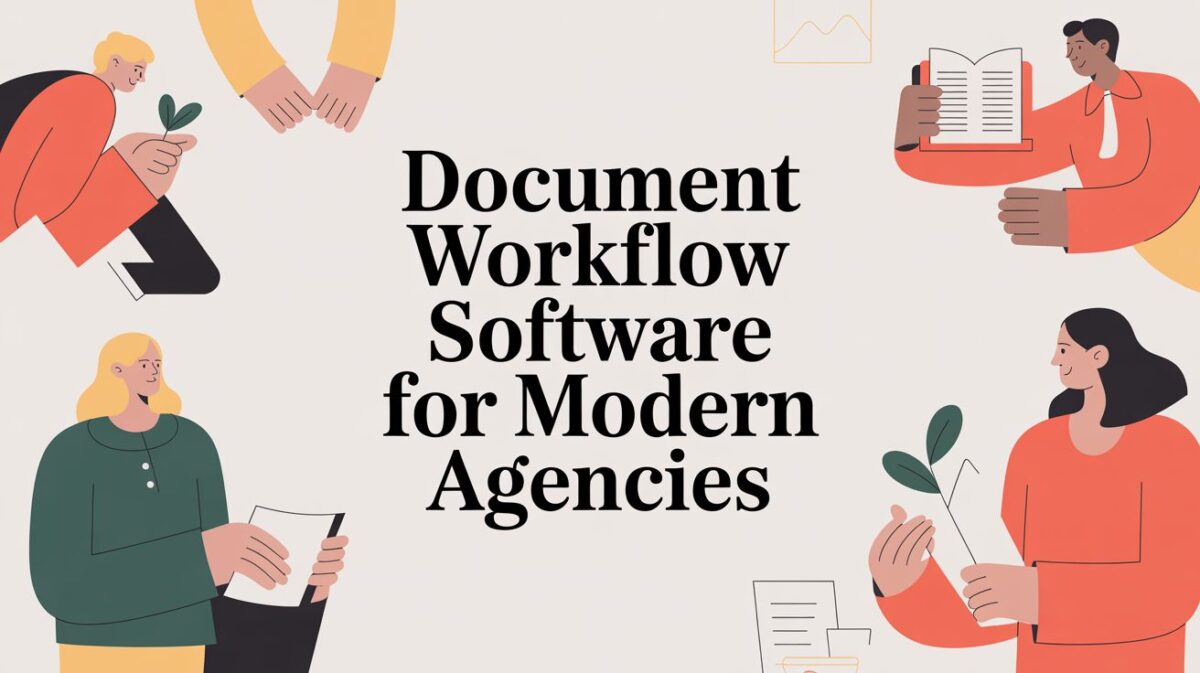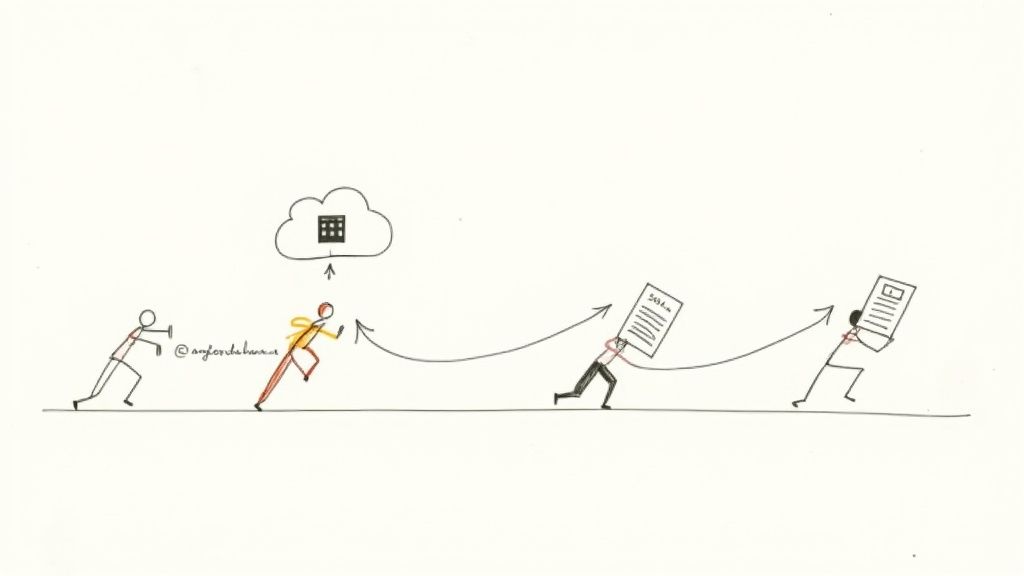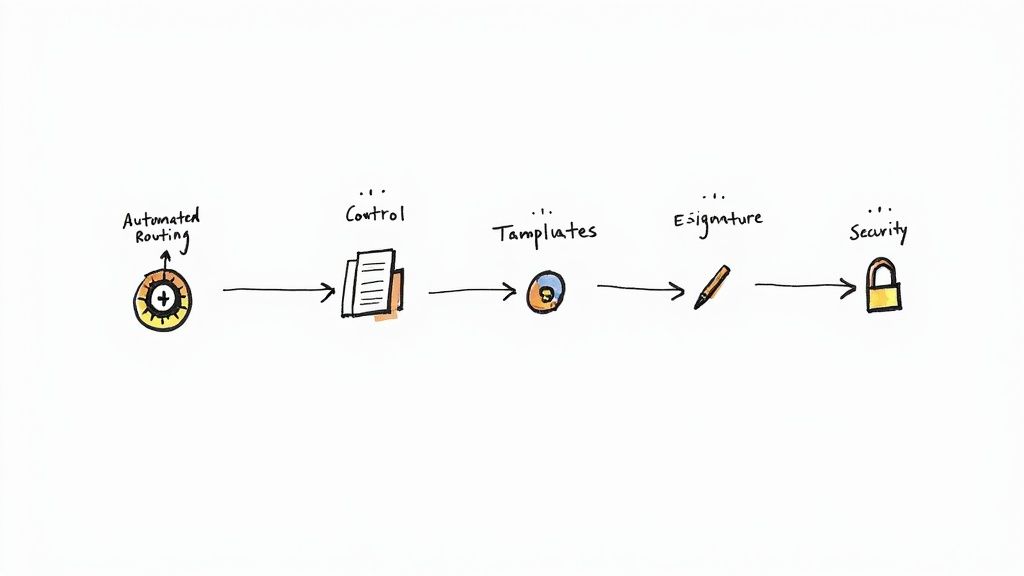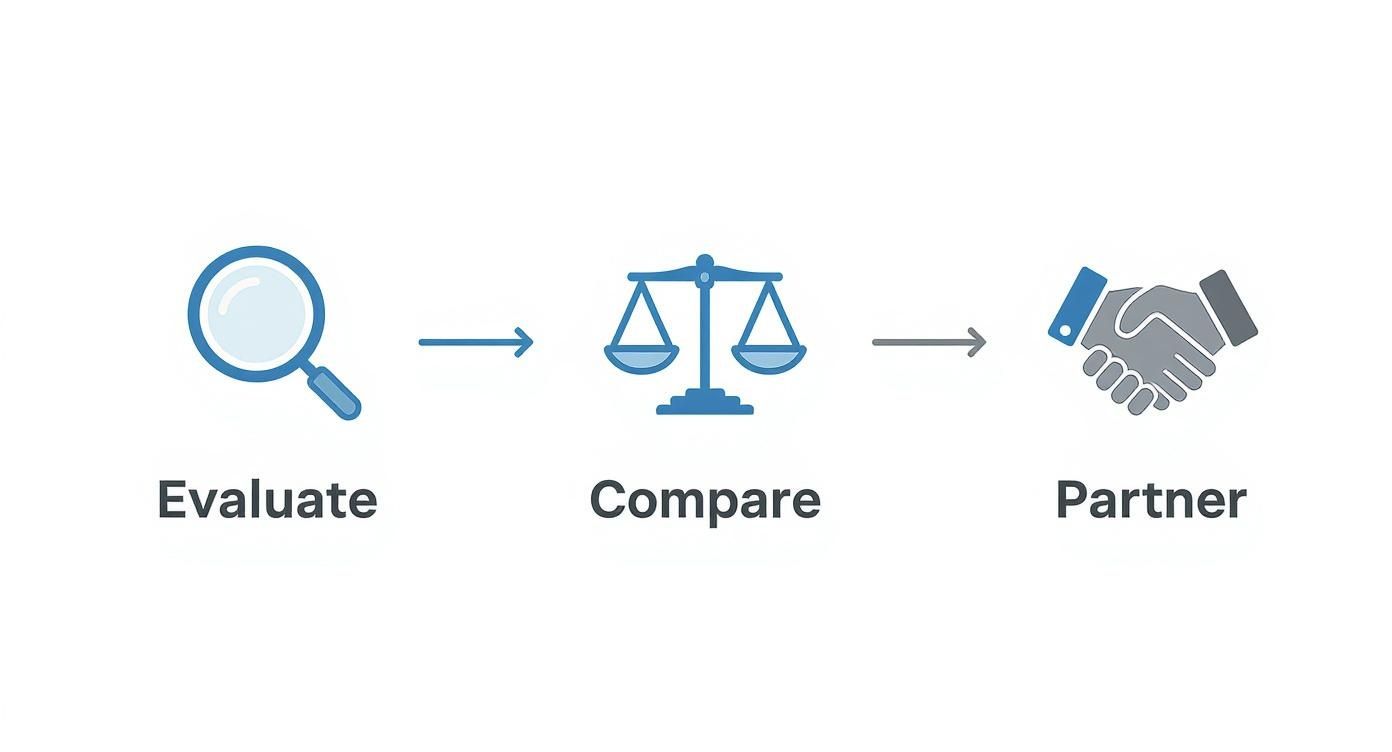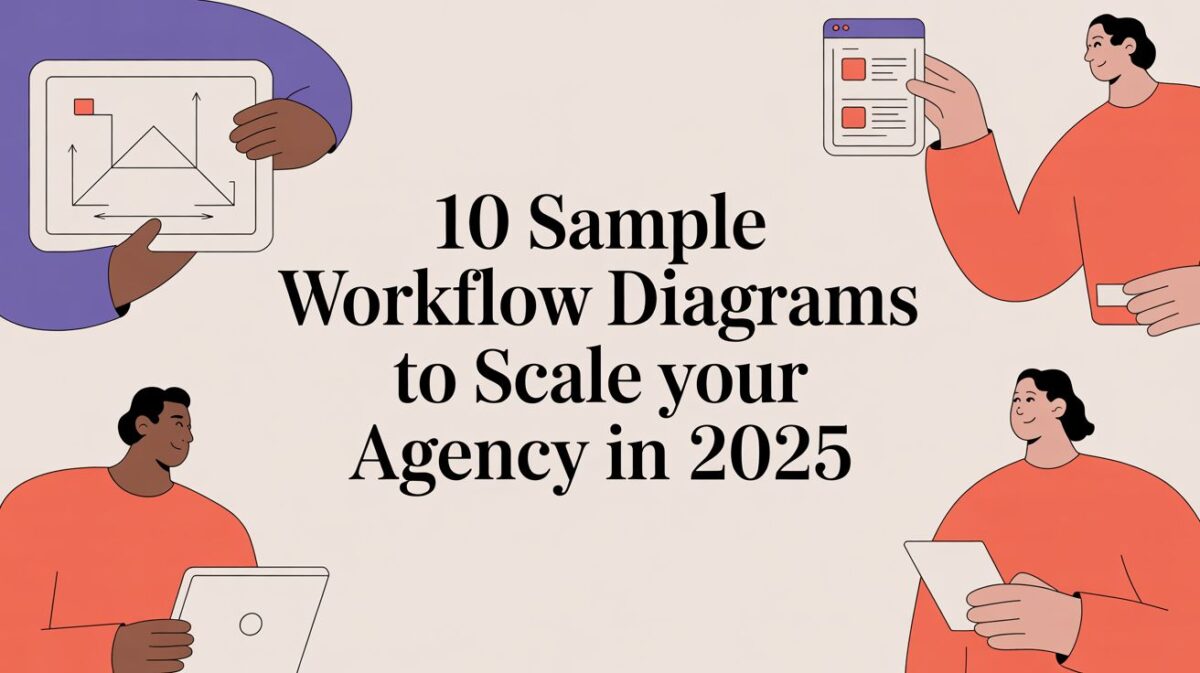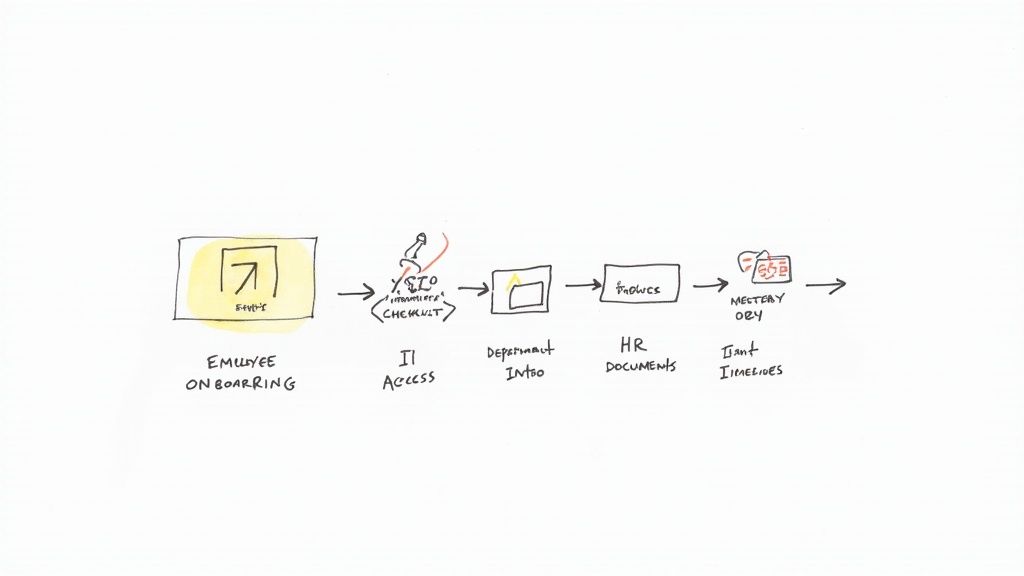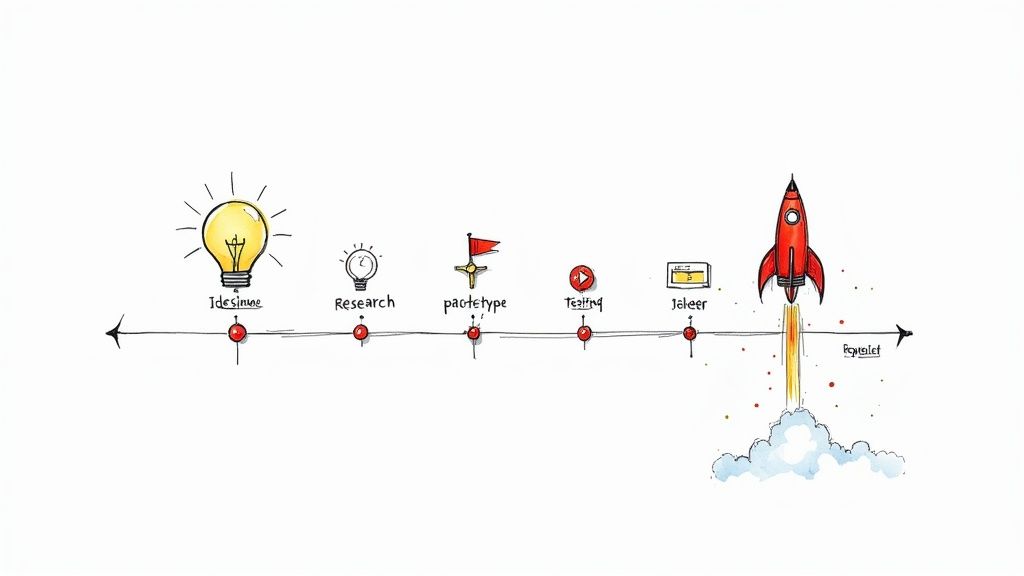project communication plan sample: 7 templates for agencies
In agency operations, projects succeed or fail based on one thing: communication. Scope creep, missed deadlines, and client frustration are rarely technical problems; they are communication breakdowns. A robust communication plan is your operational blueprint for clarity. It defines who gets what information, when, and how, turning reactive fire-fighting into proactive, predictable delivery. Without one, you're eroding profitability with every avoidable email, status meeting, and client misunderstanding. A solid project communication plan sample is the fastest way to build this essential document.
This guide provides an in-depth analysis of 7 powerful project communication plan templates sourced from platforms like Smartsheet, ClickUp, and Miro. We'll move beyond simple links and downloads, offering a tactical look at how to adapt these samples for different agency projects, from web development to ongoing retainers.
You will find:
- Annotated examples with screenshots and direct links.
- Strategic breakdowns for different project types (e.g., software, marketing, support).
- Actionable takeaways for customizing each template for your specific workflow.
We've done the research to help you find the best starting point for creating a bulletproof system that protects your team's time, manages client expectations, and secures your margins.
1. Smartsheet: The Corporate Standard for Download-and-Go Reliability
Smartsheet has established itself as a go-to resource for corporate-grade project management tools, and its template hub is a prime example of its practical, no-nonsense approach. For agency professionals who need a reliable and comprehensive project communication plan sample without committing to new software, Smartsheet offers an exceptional starting point. Their template is available for immediate download in multiple formats, making it incredibly versatile for any team's existing workflow.

The primary advantage is accessibility. There is no signup required, no paywall, and no forced trial. You can instantly download the template as an Excel, Word, Google Sheet, or PDF file, which removes any friction between identifying a need and getting a solution.
Strategic Breakdown & Key Features
Smartsheet’s template stands out because it combines a pre-filled example with clear instructions, allowing users to understand the "why" behind each section.
- Format Versatility: The availability of XLSX, DOCX, and Google Sheets formats means you can immediately integrate the template into the tools your team already uses. This avoids the learning curve associated with a new platform.
- Comprehensive Communication Matrix: The template includes a detailed, example-filled communication matrix. It clearly outlines the communication type (e.g., "Project Kickoff Meeting"), description, delivery method, frequency, audience, and owner. This structure is a perfect blueprint for agencies to customize.
- Integrated Best Practices: The webpage hosting the template also provides valuable context and best practices for creating a communication plan. This educational component adds significant value, especially for junior project managers or teams formalizing their processes.
Key Takeaway: Smartsheet excels at providing a robust, standalone document that serves as both a template and an educational tool. Its strength lies in its immediate utility and corporate-vetted structure, making it a safe and effective choice for any agency.
Practical Application Tips
To get the most out of this resource, don't just fill in the blanks. Use the provided structure as a foundation to build upon.
| Pro Tip | Actionable Step |
|---|---|
| Adapt, Don't Just Adopt | Use the provided examples as inspiration, but replace them with communication events specific to your agency's client work. |
| Centralize for Collaboration | Immediately upload the downloaded file (especially the Google Sheets version) to a shared drive to enable team collaboration. |
| Incorporate into Onboarding | Use the clean, well-structured template as a training tool for new project managers joining your agency. |
Link to Resource: Smartsheet Project Communications Plan
2. ClickUp: The Integrated Hub for Live Communication Planning
ClickUp offers a dynamic and integrated approach to communication planning, shifting the concept from a static document to a living part of your project management ecosystem. Instead of a downloadable file, ClickUp provides a project communication plan sample as a template that lives directly within its platform. This is ideal for agencies already using or willing to adopt a comprehensive project management tool, as it connects the plan directly to tasks, deadlines, and team members.

The primary advantage is its active nature. To use the template, you must sign up for ClickUp, but once inside, the plan becomes a powerful, interactive tool. You can assign owners, set recurring communication tasks, and track execution all in one place, which is a significant step up from a simple spreadsheet.
Strategic Breakdown & Key Features
ClickUp’s template is designed for action, not just reference. It leverages the platform's native features to make the communication plan a core component of project governance.
- Actionable Template: The plan is built as a ClickUp List, where each communication type (e.g., "Weekly Client Sync") is a task. This allows you to assign owners, set due dates, and add comments directly to each item.
- Custom Fields for Clarity: The template utilizes custom fields to track key details like Audience, Channel, Frequency, and Owner. This structured data can be used to sort, filter, and create different views (like a Calendar or Gantt chart) of your communication schedule.
- Built-in Automation: Agencies can leverage ClickUp’s automation features to streamline communication. For example, you can set an automation to create a recurring task for the "Weekly Status Report" or notify a team member when their communication deliverable is due.
Key Takeaway: ClickUp excels by transforming the communication plan from a passive document into an active, automated workflow. It is the best choice for agencies that want their plan to be fully integrated with their day-to-day project execution tools.
Practical Application Tips
To maximize ClickUp's template, think of it as a command center for your project's information flow, not just a list of meetings.
| Pro Tip | Actionable Step |
|---|---|
| Link to Key Docs | Use the task descriptions to link directly to meeting agenda templates, status report dashboards, or other relevant assets in your shared drive. |
| Create a Calendar View | Save a filtered Calendar view of your communication plan to give all stakeholders a clear, visual timeline of upcoming touchpoints. |
| Use Form Submissions | Create a ClickUp Form for ad-hoc communication requests from stakeholders and have submissions automatically populate your plan for review. |
Link to Resource: ClickUp Communication Plan Template
3. Miro: The Visual Workshop for Collaborative Planning
Miro shifts the concept of a communication plan from a static document to a dynamic, collaborative canvas. Its template library is a treasure trove for visually oriented teams, and its project communication plan sample is perfect for agencies that thrive on real-time workshops and iterative planning. Unlike downloadable files, Miro’s strength is in shared creation and live brainstorming.
The primary advantage is its facilitation-first approach. While a Miro account is required to use the template (a free plan is available), it unlocks a suite of collaborative tools. Teams can simultaneously add sticky notes, draw connections, and comment, making the planning process a shared, interactive experience rather than a top-down directive.
Strategic Breakdown & Key Features
Miro’s template is less a form to fill and more a framework to build upon, making it ideal for the discovery phase of a project where communication needs are still being defined.
- Real-Time Visual Collaboration: The core feature is the infinite whiteboard where multiple users can work together in real time. This is invaluable for remote or hybrid agencies looking to replicate the energy of an in-person strategy session.
- Structured Yet Flexible Framework: The template provides pre-built sections for key audiences, channels, frequency, and key messages. However, its digital nature means you can easily expand, shrink, or link these sections to other boards like a stakeholder map or a communication roadmap.
- Companion Templates: Miro doesn't just offer one template; it provides an ecosystem. You can easily pull in a separate Communication Matrix or Stakeholder Analysis template onto the same board, creating a comprehensive, interconnected planning hub.
Key Takeaway: Miro is the best choice for teams that plan collaboratively. It transforms the communication plan from a static artifact into a living document, making it exceptionally well-suited for agile projects where communication needs evolve.
Practical Application Tips
To leverage Miro effectively, embrace its visual and collaborative nature. Think of it as a digital workshop space, not just a document editor.
| Pro Tip | Actionable Step |
|---|---|
| Run a Live Workshop | Schedule a dedicated session with your project team and key stakeholders to build the plan together on the Miro board in real time. |
| Create a "Planning Hub" | Don't limit yourself to one template. Combine the Communication Plan, Stakeholder Map, and a project timeline on a single board for a holistic view. |
| Use as a Presentation Tool | Once complete, use Miro's presentation mode to walk clients and stakeholders through the plan, highlighting connections and flows visually. |
Link to Resource: Miro Communications Plan Template
4. Asana: The Integrated Hub for Actionable Communication
Asana is a powerhouse for task management, and its strength lies in connecting communication directly to the work being done. For agencies already using Asana to manage projects, its project communication plan sample is less a downloadable file and more a living, integrated part of your workflow. This approach ensures that communication isn't a separate document that gets forgotten but a dynamic plan tied to project execution.

The primary advantage is its seamless integration. By using the template, your communication plan becomes a project within Asana itself, allowing you to assign owners to specific communication tasks, set recurring deadlines for status updates, and track progress alongside project milestones. This is ideal for agencies seeking to build accountability directly into their communication processes.
Strategic Breakdown & Key Features
Asana's template transforms a static plan into a dynamic, task-driven framework. It’s built for action, not just for reference.
- Actionable Framework: The template is set up as a project list, where each communication type (e.g., "Weekly Client Update") is a task. You can assign owners, set due dates (including recurring ones), and use custom fields to track channel, audience, and frequency.
- Integrated Status Reporting: Asana's built-in "Status" feature allows project managers to create and share high-level project health updates directly within the platform. This links your communication plan to real-time project progress, providing stakeholders with a single source of truth.
- Contextual Communication: The template encourages linking the communication plan to relevant tasks, projects, and goals within Asana. This provides immediate context for anyone reviewing the plan, connecting the "what" of communication to the "why" of the project.
Key Takeaway: Asana is the best choice for teams who want their communication plan to be an active, breathing part of their project management ecosystem. Its value is maximized when your team is already committed to the Asana platform.
Practical Application Tips
To leverage Asana's full potential, integrate the communication plan deeply into your daily operations.
| Pro Tip | Actionable Step |
|---|---|
| Use Custom Fields | Create custom fields for "Audience" and "Channel" to categorize and filter your communication tasks for easy review. |
| Automate Reminders | Use Asana's Rules (available on paid plans) to create automations that remind owners of upcoming communication deadlines. |
| Link to Project Portfolios | Add your communication plan project to a Portfolio alongside your main client project to get a high-level view of both work and communication streams. |
Link to Resource: Asana Communication Plan Template
5. ProjectManagement.com (PMI): The Professional Standard for PMBOK Alignment
For agencies that adhere to or are influenced by the Project Management Institute (PMI) standards, ProjectManagement.com is the definitive source. As PMI's official community and resource hub, it offers templates that are directly aligned with the PMBOK® Guide, providing a level of professional credibility and structural rigor that is hard to find elsewhere. Their project communication plan sample is designed for formal project environments where process standardization is key.

The primary advantage of using a PMI-backed template is its industry-recognized structure. However, it's important to note that while some resources are free, many of the most valuable templates require a PMI membership for full access. This makes it an ideal resource for professionals already invested in the PMI ecosystem.
Strategic Breakdown & Key Features
The templates on ProjectManagement.com are more than just documents; they are artifacts of a disciplined project management methodology. They are built to satisfy formal requirements and ensure comprehensive planning.
- PMBOK® Alignment: Every template is designed to align with the principles outlined in the Project Management Body of Knowledge. This ensures all critical components, from stakeholder analysis to communication constraints, are covered systematically.
- Variety of Artifacts: The site offers multiple template variants, such as a "Communications Management Plan" and a "Communication Plan Log." This allows teams to select the specific document that best fits their project's complexity and formal needs.
- Extensive Resource Library: Beyond the communication plan, the platform provides access to a vast library of interconnected project deliverables. This allows an agency to build out a complete, consistent set of project documentation, from risk registers to project charters.
Key Takeaway: ProjectManagement.com provides the gold standard for formal, process-driven project communication planning. Its strength lies in its authoritative, standards-aligned templates that promote rigor and consistency, making it perfect for PMP-certified managers and agencies serving enterprise-level clients.
Practical Application Tips
To leverage these professional-grade resources effectively, focus on integrating them into your agency’s established processes rather than using them in isolation.
| Pro Tip | Actionable Step |
|---|---|
| Align with PMP Practices | If your team includes PMP-certified managers, use these templates to standardize communication planning across all projects, leveraging their training. |
| Use as a Training Standard | Introduce the PMI template as the "gold standard" during training to teach junior PMs the components of a comprehensive communication strategy. |
| Justify the Investment | If considering a PMI membership, frame it as an investment in professional development and access to a complete suite of best-practice templates. |
Link to Resource: ProjectManagement.com Communications Plan
6. Template.net: Polished Documents for Client-Facing Presentations
Template.net offers a vast library of professionally designed templates, making it a valuable resource for agencies that need to produce polished, client-ready documents quickly. Unlike platform-integrated tools, its strength lies in providing a project communication plan sample that looks like a finished deliverable from the moment you download it. This is ideal for formal presentations or when including the plan in a larger project proposal binder.

The platform caters to users who prefer working in traditional document editors like Word, Google Docs, or Apple Pages. While many templates are behind a paywall, the variety and design quality can justify the cost for agencies that frequently need to create impressive documentation without spending hours on formatting.
Strategic Breakdown & Key Features
Template.net differentiates itself with its sheer volume and aesthetic focus, offering numerous industry-specific variations that go beyond a generic project management framework.
- Format and Design Focus: Templates are available in DOCX, Google Docs, Pages, and PDF, prioritizing print-readiness and visual appeal. They often include cover pages, tables of contents, and pre-formatted branding elements.
- Niche-Specific Variations: The site provides specialized templates for different contexts, such as construction projects, IT rollouts, or marketing campaigns. This allows agencies to find a starting point that is already closely aligned with their specific project needs.
- Ready-to-Edit Content: The templates come with well-written, placeholder copy that guides the user on what to include in each section. This accelerates the drafting process and helps ensure all critical components are covered.
Key Takeaway: Template.net is the go-to resource when the presentation of the communication plan is as important as its content. It's best for creating high-quality, standalone documents for formal client reviews or internal sign-offs.
Practical Application Tips
To maximize the value of Template.net, treat its offerings as a professional design foundation rather than just a content fill-in.
| Pro Tip | Actionable Step |
|---|---|
| Invest in a Subscription | If your agency regularly creates formal project documentation, a subscription offers better value than purchasing templates individually. |
| Customize the Branding | Use the polished layout as a base. Immediately apply your agency’s logo, color scheme, and typography to make the document your own. |
| Create a Master Template | Download a preferred format and customize it fully. Save this as your agency’s official communication plan template for future projects. |
Link to Resource: Template.net Project Communication Plan
7. Etsy: The Creative Marketplace for Budget-Friendly Templates
Etsy, known primarily for handmade goods, is also a bustling marketplace for digital templates created by independent designers and project management professionals. For agencies seeking a project communication plan sample with a bit more visual flair or a specific layout at a low cost, Etsy provides an unexpected and valuable resource. It's an ideal source for finding a unique template that can be easily branded for client-facing documents.

The key advantage is the sheer variety and affordability. Unlike corporate platforms, Etsy sellers offer a wide range of designs, from minimalist spreadsheets to colorful, presentation-ready documents. Since these are instant digital downloads, you can purchase and start using a new template within minutes for just a few dollars.
Strategic Breakdown & Key Features
Etsy’s value comes from its community-driven marketplace, where you can find niche templates that suit a specific agency aesthetic or project type.
- Design & Layout Variety: Sellers offer countless styles. This allows agencies to find a template that matches their branding or a client's specific visual identity, adding a layer of professionalism that a standard spreadsheet might lack.
- Affordable & Accessible: Most templates are priced under $10, making it a highly cost-effective way to build a library of communication tools. The instant download feature in formats like Excel, Google Sheets, and Word ensures immediate usability.
- Social Proof Through Reviews: The platform's review system is its greatest asset. You can read feedback from other project managers and see user-submitted photos to gauge the quality, usability, and comprehensiveness of a template before buying.
Key Takeaway: Etsy is the go-to for aesthetically pleasing and highly affordable project communication templates. While quality varies, leveraging seller reviews allows you to find a high-quality, visually engaging document that corporate sites don't offer.
Practical Application Tips
To find the best templates on a marketplace like Etsy, you need to be a savvy shopper. Focus on sellers with strong reviews and clear product descriptions.
| Pro Tip | Actionable Step |
|---|---|
| Filter by Top-Rated Sellers | Prioritize templates from sellers with a high number of positive reviews and "Bestseller" badges to ensure quality and support. |
| Check for Bundles | Many sellers offer project management bundles that include a communication plan alongside other useful tools for one low price. |
| Customize for Your Brand | Once you download the file, immediately update the colors, fonts, and add your agency’s logo to make it a reusable internal asset. |
Link to Resource: Etsy Communications Template Marketplace
Project Communication Plan: Top 7 Comparison
| Tool | Complexity 🔄 | Resources & Access ⚡ | Expected outcomes 📊 | Ideal use cases 💡 | Key advantages ⭐ |
|---|---|---|---|---|---|
| Smartsheet | Low — download & edit static files | No signup; multiple formats (XLSX, DOCX, Google Sheets, PDF) | Ready-made, example-filled communication plans | Quick deliverables; offline editing; consultants | Fast access; corporate-grade templates |
| ClickUp | Medium — add template to workspace; configure automations | Requires ClickUp account; advanced features often paid | Managed, trackable communication plan inside PM workflows | Teams using ClickUp seeking integrated planning | Strong PM features, automations, multiple variants |
| Miro | Low–Medium — duplicate board; facilitate visually | Free account to duplicate; collaboration features per plan | Visual, workshop-ready plans and stakeholder maps | Remote workshops, stakeholder mapping, iteration | Real-time visual collaboration; companion templates |
| Asana | Medium — copy into project; set custom fields/recurrences | Free for basic use; integrations and advanced automations may be paid | Aligned communications tied to tasks and timelines | Teams already using Asana for project work | Tight task-communication alignment and visibility |
| ProjectManagement.com (PMI) | Medium — download standards-oriented templates | Many templates require PMI membership or purchase | PMBOK-aligned communications artifacts and logs | Project managers needing standards and formal deliverables | Reputable, standards-aligned content; extensive library |
| Template.net | Low — download and customize documents | Large catalog; many paid templates; multiple file formats | Polished, client-ready documents across industries | Consultants and client deliverables requiring polished layouts | Wide industry variety; print-ready, editable layouts |
| Etsy | Low — purchase & download per seller | Low-cost options; quality varies by seller; instant downloads | Budget-friendly, design-varied templates | Small businesses or individuals seeking inexpensive designs | Affordable prices; variety of visual styles and previews |
From Template to System: Making Your Communication Plan an Asset, Not an Artifact
We've explored a diverse range of project communication plan samples, from the structured spreadsheets of Smartsheet and PMI to the flexible canvases of Miro and the integrated task management of Asana and ClickUp. Each template provides a solid foundation, offering a stakeholder matrix, communication schedule, and escalation paths tailored for different agency projects, whether it's a complex software build or an ongoing marketing retainer.
The central lesson is clear: a template is not the end goal. Its true power is unlocked when it transforms from a static document into a dynamic, living system integrated directly into your agency’s daily operations. A plan sitting in a shared drive is an artifact; a plan driving automated reminders, informing client dashboards, and guiding team check-ins is an asset.
Key Takeaways for Activating Your Communication Plan
To ensure your plan becomes an active driver of project success, focus on these core principles:
- Adapt, Don't Just Adopt: The most effective project communication plan sample is the one you customize. Use the provided examples as a starting point, but rigorously tailor the channels, frequency, and messaging to fit your specific client's personality, your team's workflow, and the project's unique risks.
- Centralize Your Communication Hub: Disjointed communication is a project killer. Whether you choose Asana, ClickUp, or another platform, designate a single source of truth. All status updates, stakeholder messages, and meeting notes should live or be linked there to eliminate confusion and wasted time.
- Automate for Consistency: Manual updates are prone to human error and forgetfulness. Leverage your chosen tool's automation features to schedule recurring reports, send reminders for check-ins, and notify stakeholders of key milestone completions. This builds trust through predictable, reliable communication.
- Make It Visible: Your plan should be easily accessible to everyone involved. Pin it to a project channel in Slack, embed it in your project management dashboard, and review it during the project kickoff. Visibility ensures alignment and reinforces accountability.
Choosing the Right Tool to Bring Your Plan to Life
The tools we reviewed each serve different primary functions. Your choice should align with your agency's existing tech stack and specific needs.
- For Data-Driven Rigor: If your projects demand detailed tracking and reporting, a tool like Smartsheet offers powerful, spreadsheet-like functionality.
- For Visual Collaboration: When brainstorming and mapping complex stakeholder relationships, Miro provides an unparalleled collaborative canvas.
- For Integrated Task Management: If you want communication embedded directly with the work, Asana and ClickUp are excellent choices for turning plans into actionable tasks.
The ultimate goal is to move beyond simply documenting a plan. You need to build an operational system where communication is seamless, intentional, and integrated. This requires a platform that connects your project tasks, client history, and team conversations, transforming your communication plan from a theoretical guide into an intelligent workflow. A truly integrated system can flag a missed update or sense a shift in client sentiment, enabling you to act proactively, not reactively. By focusing on this systemic approach, you build more than a successful project; you build a scalable, chaos-free agency.
Ready to turn your communication plan from a static document into an automated engine for client trust and project success? RGK unifies your projects, tasks, and client communication in one intelligent platform, ensuring your plans are always connected to the work being done. Discover how to build a truly integrated system at RGK.
Article created using Outrank
